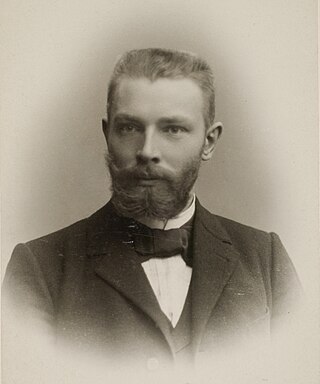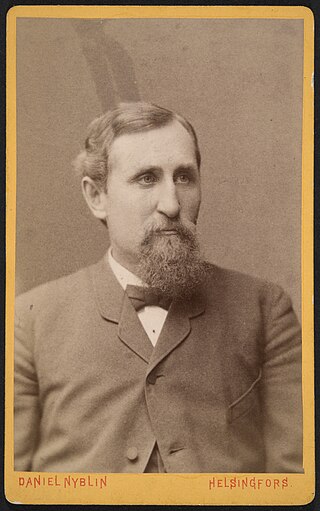
Edvard Alexander Westermarck was a Finnish philosopher and sociologist. Among other subjects, he studied exogamy and the incest taboo.

The University of Helsinki is a public university in Helsinki, Finland. The university was founded in Turku in 1640 as the Royal Academy of Åbo under the Swedish Empire, and moved to Helsinki in 1828 under the sponsorship of Tsar Alexander I. The University of Helsinki is the oldest and largest university in Finland with the widest range of disciplines available. In 2020, around 31,600 students were enrolled in the degree programs of the university spread across 11 faculties and 11 research institutes.

The Sibelius Academy is part of the University of the Arts Helsinki and a university-level music school which operates in Helsinki and Kuopio, Finland. It also has an adult education centre in Järvenpää and a training centre in Seinäjoki. The Academy is the only music university in Finland. It is among the biggest European music universities with roughly 1,400 enrolled students.
Inspektor or inspehtori, Swedish and Finnish for inspector, is the largely honorary chairman of student nations in Lund and Uppsala universities in Sweden and University of Helsinki in Finland. The inspektor has a supervisory role in their nation and presides over most important functions. It is a quite prestigious role to be invited to undertake as it implies the trust and respect of the student community. The inspektor may be of either gender and is usually a professor. The position originated at The Royal Academy of Turku in 1643 as a way for the university administration to keep watch on the student population after it was realised that the university was unable to forbid the nation system outright. The universities at Uppsala and Lund followed soon after.

The Student Union of the University of Helsinki was founded in 1868. It currently has 32,000 members and is one of the world's richest student organizations, with assets of several hundred million euros. Among other things, it owns a good deal of property in the city centre of Helsinki.

The Academic Male Voice Choir of Helsinki, abbreviated AS, colloquially also known as Akademen, is a Finland-Swedish academic male-voice choir in Helsinki, Finland. The choir was founded in 1838 by Fredrik Pacius and is the oldest extant choir in Finland. It is one of two male-voice choirs affiliated with the University of Helsinki, the other being the oldest extant Finnish-language choir, the YL Male Voice Choir. Furthermore, it is one of two Swedish-language choirs affiliated with the University of Helsinki, the other being the Academic Female Voice Choir Lyran.

In Finland, student nations are student organisations within which a large proportion of extra-curricular student activity takes place. Though membership is not compulsory, the nations provide one of the main nodes of student social life, along with the faculty-based organisations (ainejärjestöt) at the universities.

Carl Axel Gottlund was a Finnish explorer, collector of folklore, historian, cultural politician, linguist, philologist, translator, writer, publisher and lecturer of Finnish language at the University of Helsinki. He was a colorful cultural personality and one of the central Finnish national awakeners and — later — one of the leading dissidents at the same time.
The following is a timeline of the history of the city of Helsinki, Finland.

Valter Thomé was a Finnish architect who worked in the National Romantic or Art nouveau style.

The Academic Female Voice Choir Lyran, also referred to as simply Lyran, is a Finland-Swedish academic female voice choir in Helsinki, Finland. It is the only women's choir affiliated with the University of Helsinki.

Karl Hård af Segerstad was a Finnish architect. He came from a Swedish family, but lived and worked his whole life in Finland, mainly in Helsinki and Viipuri. He was appointed city architect of Helsinki in 1907. One of his most famous works is the Nylands Nation building (1899–1901) at the University of Helsinki in Helsinki.

Florakören vid Åbo Akademi, also referred to as simply Florakören or Flora, is a Finland-Swedish academic women's choir in Turku, Finland.

The Invasion of Åland was a 1918 military campaign of World War I in Åland, Finland. The islands, still hosting Soviet Russian troops, were first invaded by Sweden in late February and then by the German Empire in early March. The conflict was also related to the Finnish Civil War including minor fighting between the Finnish Whites and the Finnish Reds.

Georg Didrik Boldt was a Finnish philosopher of religion who was known as a socialist and tolstoyan.

Edvard August Vainio was a Finnish lichenologist. His early works on the lichens of Lapland, his three-volume monograph on the lichen genus Cladonia, and, in particular, his study of the classification and form and structure of lichens in Brazil, made Vainio renowned internationally in the field of lichenology.

Fredrik Emil Volmar Elfving was a Swedish-speaking Finnish botanist, plant physiologist, and university administrator. During his university training, he frequently traveled abroad to learn new scientific methods and techniques from other prominent European scientists. Although his earliest publications dealt with phytogeography and phycology, his most notable research was in plant physiology. Early in his career, he published seminal work on the flow of water through the stems of woody plants, and investigated the phenomenon of transversely geotropic plant organs. In contrast to his works on plant physiology, his later experiments and views on lichens, which he himself considered his most important work, was far less favourably received.

Frans Viktor Heikel was a Finland-Swedish gymnastics teacher, known as "the father of Finnish school gymnastics".

















